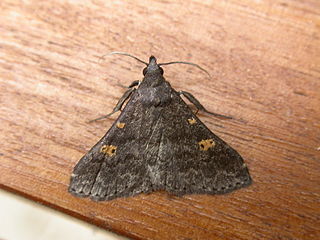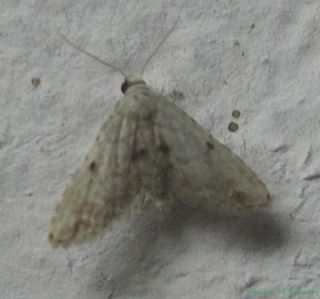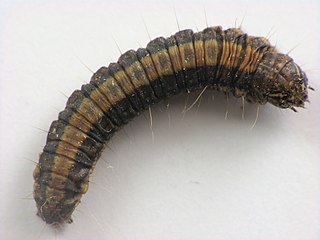Naarda calliceros is a species of moth in the family Noctuidae first described by Alfred Jefferis Turner in 1932.
Naarda leptotypa is a species of moth in the family Noctuidae first described by Alfred Jefferis Turner in 1932.

Naarda is a large genus of erebid moths currently encompassing 108 species. Initially identified by Francis Walker in 1866, it is in the family Erebidae. Somewhat ruddy in appearance, this genus is distinguishable for its generally slender thorax and abdomen, and straight, porrect labial palpi. Most species are a light tan color, but shading can reach as deep as a charcoal, with muddy yellow, conspicuous reniform, orbicular stigmata featured on the forewings, sometimes reflected bilaterally superior.

Agathodes is a genus of moths of the family Crambidae. The genus was first described by Achille Guenée in 1854.
Macrobela is a monotypic moth genus of the family Crambidae described by Alfred Jefferis Turner in 1939. It contains only one species, Macrobela phaeophasma, described by the same author in the same year, which is found in Australia, where it has been recorded from Queensland.

Neostege is a genus of moths of the family Crambidae described by George Hampson in 1910. It contains only one species, Neostege holoxutha, described in the same article, which is found in Zambia and Zimbabwe.
Otiophora is a genus of moths of the family Crambidae first described by Alfred Jefferis Turner in 1908.

Sufetula is a genus of moths of the family Crambidae.

Araeopteron is a genus of moths of the family Erebidae. The genus was erected by George Hampson in 1893.

Callyna is a genus of moths of the family Noctuidae.
Diplothecta is a monotypic moth genus of the family Noctuidae. Its only species, Diplothecta loxomita, occurs in Queensland, Australia. Both the genus and species were first described by Alfred Jefferis Turner, the genus in 1920 and the species 12 years earlier in 1908.

Rivula is a genus of moths in the family Erebidae described by Achille Guenée in 1845.

Idiodes is a genus of moths in the family Geometridae first described by Achille Guenée in 1858.

The Epipaschiinae are a subfamily of snout moths. More than 720 species are known today, which are found mainly in the tropics and subtropics. Some occur in temperate regions, but the subfamily is apparently completely absent from Europe, at least as native species. A few Epipaschiinae are crop pests that may occasionally become economically significant.

Indarbela is a genus of moths in the family Metarbelidae described by Thomas Bainbrigge Fletcher in 1922.

Midilinae is a subfamily of the lepidopteran family Crambidae. It was described by Eugene G. Munroe in 1958. The 11 genera altogether comprise 59 species, with the majority of them occurring in the Neotropical realm, whereas the species of the genera Dolichobela and Styphlolepis are found in Australia.
Archernis argocephala is a moth in the family Crambidae. It was described by Oswald Bertram Lower in 1903. It is found in Australia, where it has been recorded Queensland.
Bryophilopsis is a genus of moths of the family Nolidae. The genus was described by George Hampson in 1894.
Metasia phragmatias is a moth in the family Crambidae. It was described by Oswald Bertram Lower in 1903. It is found in Australia, where it has been recorded from Queensland.










